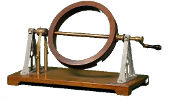» Thomson Replenisher (Recharger) (0664)
Immagini
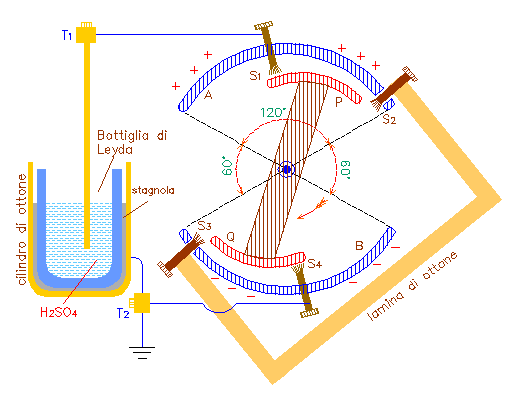
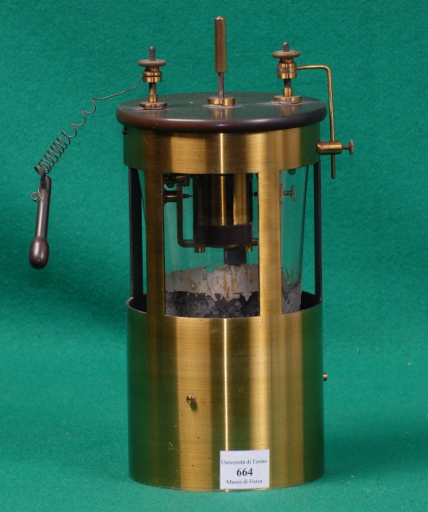
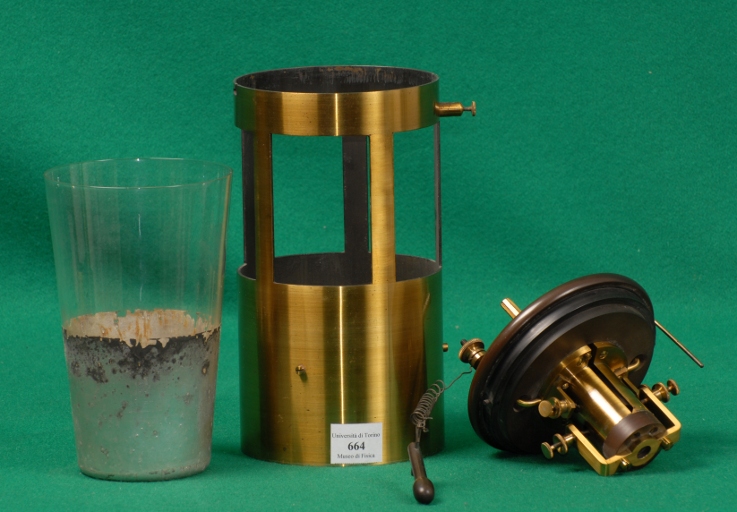
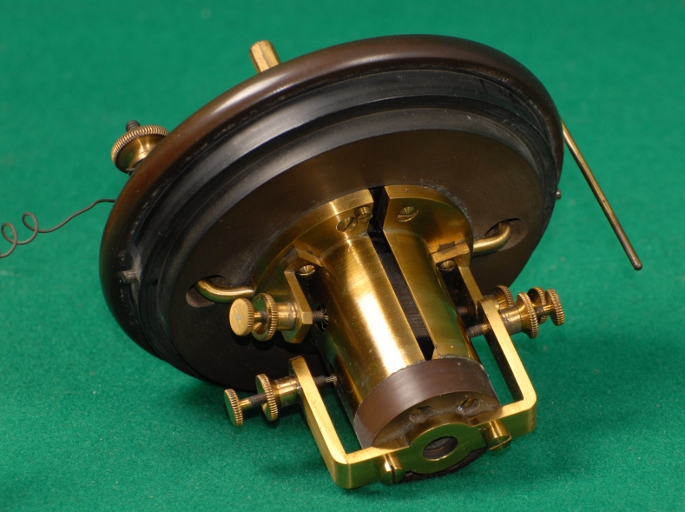
DESCRIPTION
Exhibit 664 is an electrostatic inductive recharger designed by Sir William Thomson (lord Kelvin) in 1868 for maintaining constant the voltage at his electrometer. In fact Thomson had re-invented an apparatus already designed by others, in particular by Giuseppe Belli, who in 1830 had constructed a similar device, called "duplicator", [3], and by C.F.Varley who had patented a similar device in 1860.
Our recharger maintains constant the charge in a Leyden bottle. The sign of the charge is determined by the direction of rotation, positive in one sense and negative in other.
The apparatus is a brass cylinder with 5 windors 5 cm wide and 7 cm high. The glass Leyden jar is inside the cylinder held up by a spring and covered by a tin sheet; the spring guarantees contact between the brass cylinder and the tin cover. Sulfuric acid was poured in the Leyden bottle to secure conductivity and keep the air dry. The recharger is mounted below an insulating material (bakelite) attached rigidly to the cylinder.
As shown in Design-1, the recharger consists of two concentric cylindrical brass structures, the external (AB) one fixed to the bakelite cover and the inner one (PQ) attached to the rotation axis which extends beyond the cover to facilitate the external rotation of the PQ section with a handle (now missing).
During the rotation, the internal sheets P and Q, connected by insulating material, enter alternately in contact with two metal brushes (S1 e S4) fixed in the external sheets A and B. During the rotation, the internal sheets P and Q, connected by insulating material, enter alternatively in contact with two metal brushes (S1 e S4) inserted into the external sheets A and B, and accessible through two terminals diametrically opposed on the bakelite roof, as also with two other metallic brushes (S2 and S3, in contact but insulated from the rest of the system.
The sheet A is in contact with the sulfuric acid in the Leyden jar while sheet B is at ground potential being connected to the external brass container.
To understand its functioning, suppose inductor A has an initial weak positive charge from a charge carrier and now follow the carrier P through its rotation (for Q the path is the same except with opposite charge) Ne consegue un procedimento di carica molto efficace dell'acido solforico, a contatto con A, secondo una legge di progressione geometrica rispetto al numero di cicli.
Supposing initially neutral e in contact with S2, the carrier P is charged negative by induction with respect to A, transferring the same charge to Q (through the contact S2-S3). The inductive effect is efficiently utilyzed thanks to the clever spatial disposition of the brush S2 inside a hole made in the sheet A, with which there is no contact. The carrier Q, arrived at brush S1, transfers part of its positive charge to sheet A. In the meantime P is grounded through brush S4, and is thus reinitialized. At the same time Q charges negatively in correspondence with S2, but the charge transfer is now greater due to a greater induction due to the greater positive charge on A respect to the preceding cycle.
There follows an efficient charging of the sulfuric acid in contact with A according to a geometric progression respect to the number of cycles.
BIBLIOGRAPHY
- [1] Oreste Murani, "Trattato Elementare di Fisica" Vol II, Ulrico Hoepli Milano, 1931. Pgg. 386 - 388.
- [2] James Dredge, "Electric Illumination", Vol II, John Willy and Sons. New York. 1885. Pagg.26 - 28.
- [3] A. Rovida, "Il duplicatore del Belli e Il Replenisher di Lord Kelwin (Sir William Thomson)", Il Nuovo Cimento (1895 -1900) Volume 1. Number 1, 310 -312.
- [4] P. Fleury e J.P. Mattieu,"Elettrostatica Corrente continua Magnetismo", Zanichelli Bologna, para 21.3 , Pag. 494.
- [5] SIR WILLIAM THOMSON, "REPRINTS OF PAPERS ON ELECTROSTATICS AND MAGNETISM", Second Edition, Macmillan & Co. London,1884. Pag.334. URL [ http://www.archive.org/details/reprintofpaperso00kelvrich ]
Dati Catalografici
| Data di costruzione: | --- |
|---|---|
| Data di carico: | Ignota |
| Nr. Inventario: | Ignoto (Ignoto) |
| Costruttore: | Costruttore sconosciuto |
| Materiale: | ottone, metallo, bakelite, vetro |
| Dimensioni: | altezza complessiva: 24 cm; diametro del cilindro ottone: 10 cm; altezza del vaso di vetro (bottiglia di Leyda):14 cm; |
| Conservazione: | buono ( La stagnola all'esterno della bottiglia di Leyda è un po' rovinata. ) |
